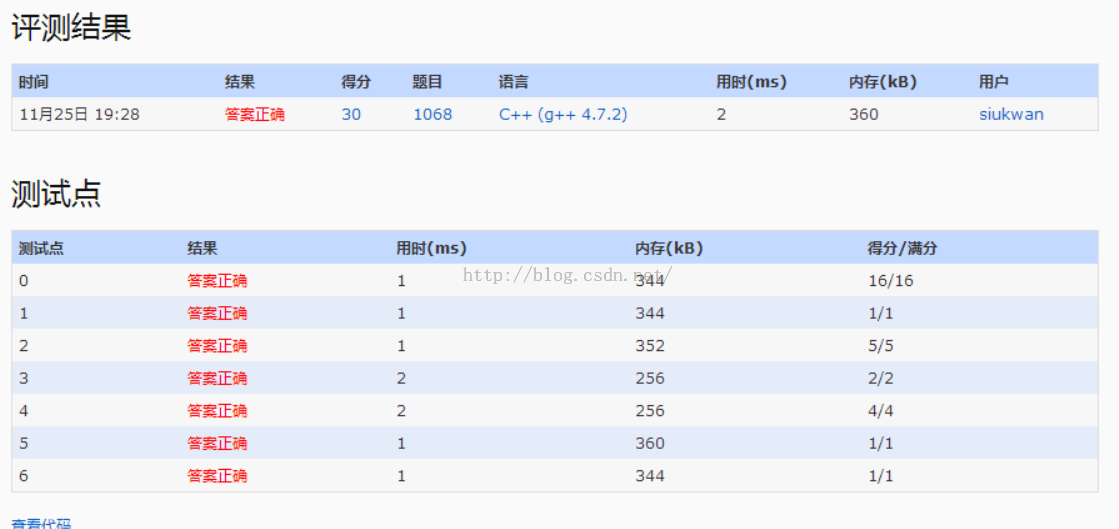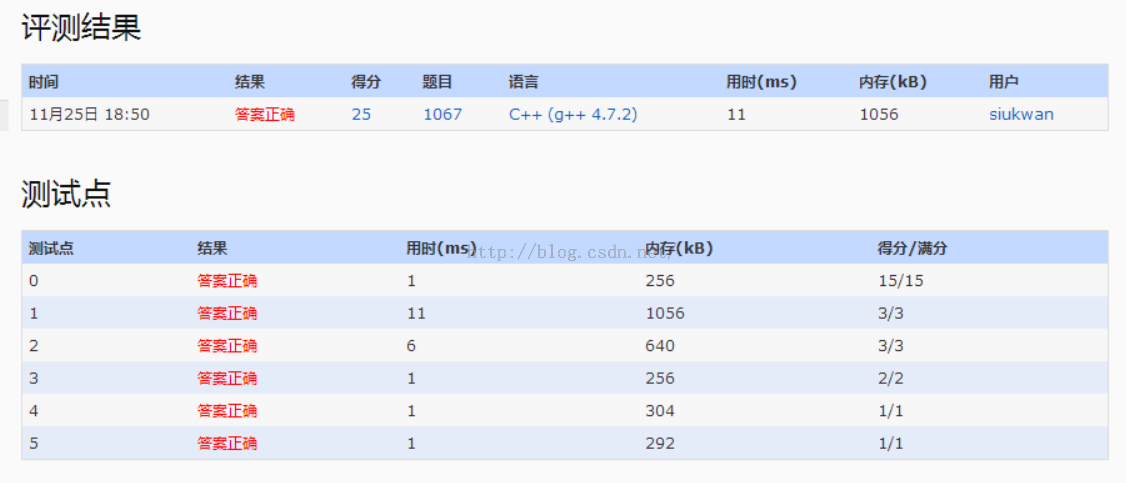1.为了求最大匹配,我们可以把顶点集分为左边集合和右边集合,那么我们希望每一个在左边的点都尽量找到右边的一个点和它匹配。
2.依次遍历左边集合中点x的邻居y(y在右边集合中),如果y之前没有被匹配,那么(x,y)形成一个匹配,匹配数+1;如果y已经被匹配,假设x’与y匹配,那么尝试给x’找一个新的匹配,如果x’能够有一个新的匹配y’,那么匹配从原来的(x’,y)变为(x’,y’)和(x,y),匹配数+1。
3.给x’找匹配的过程可以利用递归解决。
4.最后题目中提到两个优化:
(1)把顶点分为两个集合,只遍历其中一个集合即可,因为最大匹配数不超过任意一个集合的大小。另外,假设不分为两个集合,我们依次遍历所有顶点,那么我们得到的匹配数maxMatch会是所求答案的两倍,所以不分集合时,输出maxMatch/2。
(2)在遍历点x时,增加一个访问数组,标记点i是否被访问过,如果被访问过,那么在递归的时候就没必要再次访问判断了。每次遍历新的点时,这个访问数组需要清零。
5.采用如下数据结构:
[c language=”++”]
struct UserNode{
vector<int> list;//user的邻居
int type;//user类型
int from;//与user匹配的点 from—>user
UserNode() :list(0), type(-1),from(-1){};
};
[/c]
题目如下:
时间限制:10000ms
单点时限:1000ms
内存限制:256MB
描述
上一回我们已经将所有有问题的相亲情况表剔除了,那么接下来要做的就是安排相亲了。因为过年时间并不是很长,所以姑姑希望能够尽可能在一天安排比较多的相亲。由于一个人同一天只能和一个人相亲,所以要从当前的相亲情况表里选择尽可能多的组合,且每个人不会出现两次。不知道有没有什么好办法,对于当前给定的相亲情况表,能够算出最多能同时安排多少组相亲呢?
同样的,我们先将给定的情况表转换成图G=(V,E)。在上一回中我们已经知道这个图可以被染成黑白两色。不妨将所有表示女性的节点记为点集A,表示男性的节点记为点集B。则有A∪B=V。由问题可知所有边e的两个端点分别属于AB两个集合。则可以表示成如下的图:
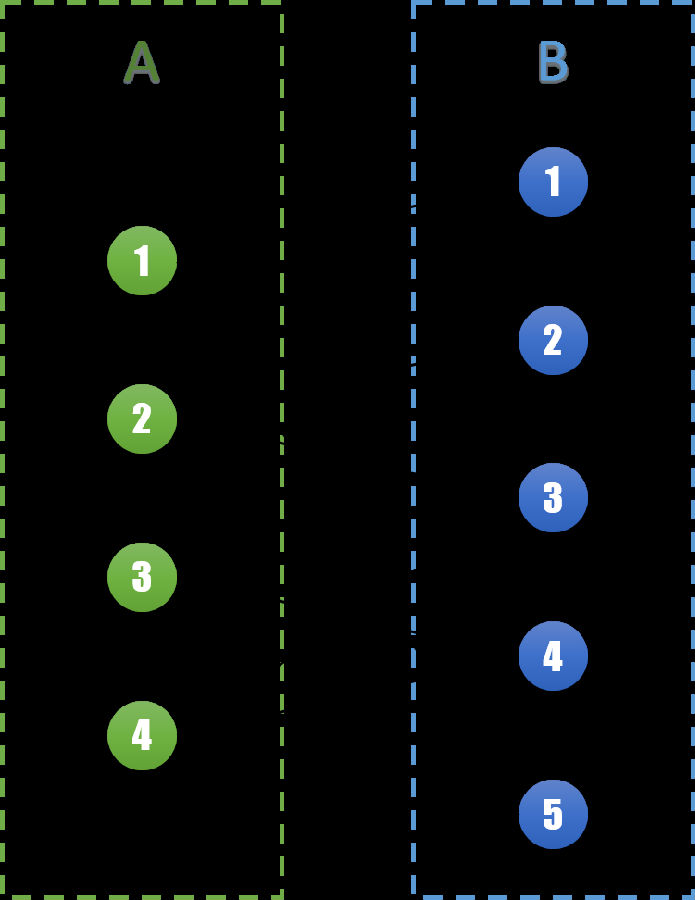
同样的,我们将所有的边分为两个集合。集合S和集合M,同样有S∪M=E。边集S表示在这一轮相亲会中将要进行的相亲,边集M表示在不在这一次进行。对于任意边(u,v) ∈ S,我们称u和v为一组匹配,它们之间相互匹配。在图G,我们将边集S用实线表示,边集M用虚线表示。得到下图:
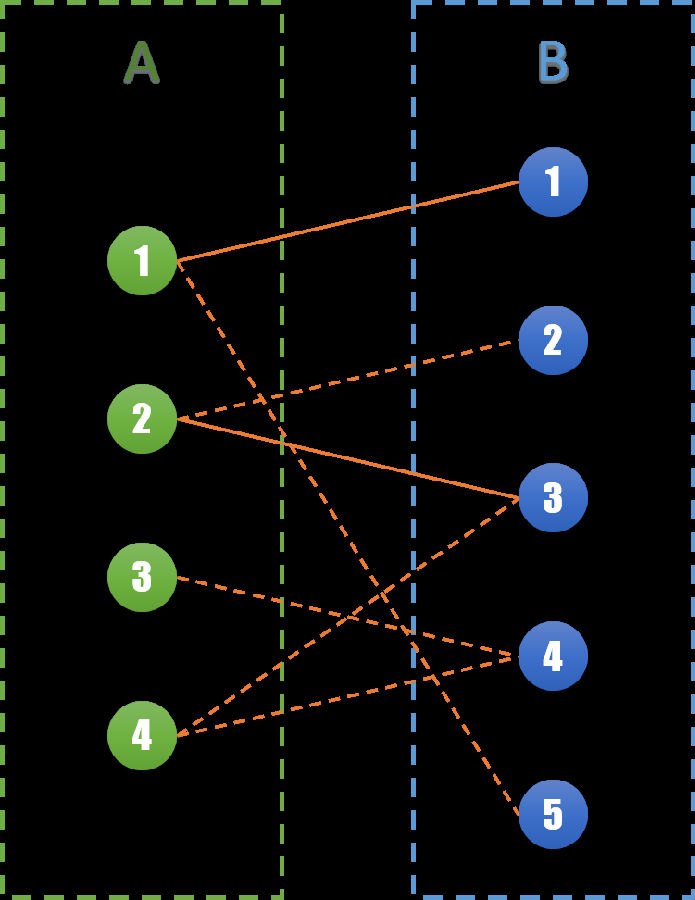
则原问题转化为,最多能选择多少条边到集合S,使得S集合中任何两条边不相邻(即有共同的顶点)。显然的,|S|<=Min{|A|, |B|}。
那么能不能找到一个算法,使得能够很容易计算出尽可能多的边能够放入集合S?我们不妨来看一个例子:

对于已经匹配的点我们先不考虑,我们从未匹配的点来做。这里我们选择A集合中尚未匹配的点(A3和A4)考虑:
对于A3点,我们可以发现A3与B4右边相连,且都未匹配。则直接将(A3,B4)边加入集合S即可。

对于A4点,我们发现和A4相连的B3,B4点都已经匹配了。但是再观察可以发现,如果我们将A2和B2相连,则可以将B3点空出来。那么就可以同时将(A2,B2),(A4,B3)相连。将原来的一个匹配变成了两个匹配。
让我们来仔细看看这一步:我们将这次变换中相关联的边标记出来,如下图所示紫色的3条边(A2,B2),(A2,B3),(A4,B3)。
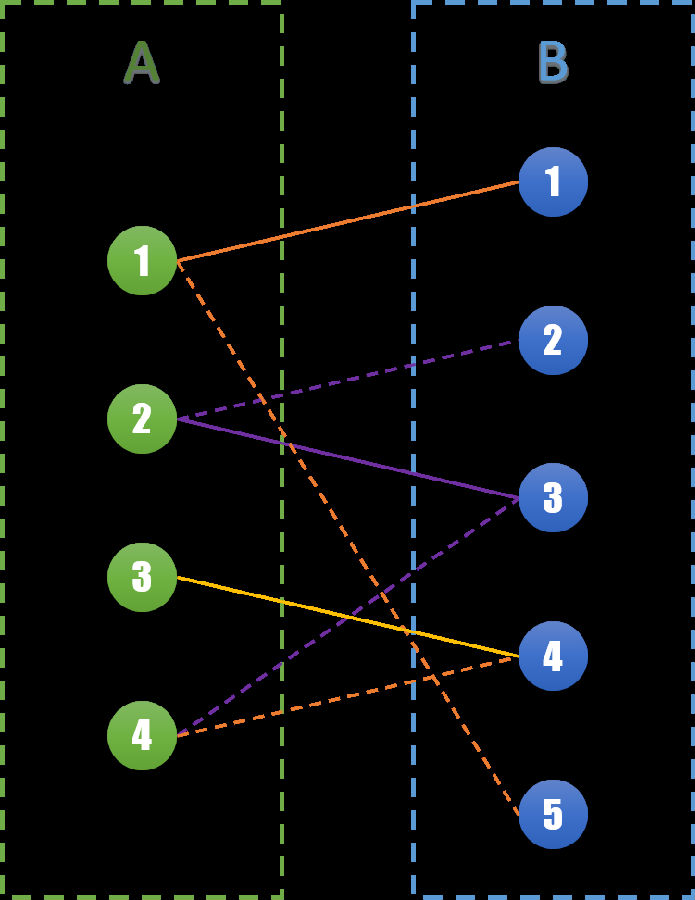
这三条边构成了一条路径,可以发现这条路径有个非常特殊的性质。虚线和实线相互交错,并且起点和终点都是尚未匹配的点,且属于两个不同的集合。我们称这样的路径为交错路径。
再进一步分析,对于任意一条交错路径,虚线的数量一定比实线的数量多1。我们将虚线和实线交换一下,就变成了下面的图:

在原来1个匹配的基础上,我们得到了2个新的匹配,S集合边的数量也增加了1。并且原来在已经匹配的点仍然是已经匹配的状态。
再回头看看A3点匹配时的情况:对于(A3,B4)这一条路径,同样满足了交错路径的性质。
至此我们得到了一个找新匹配的有效算法:
选取一个未匹配的点,查找是否存在一条以它为起点的交错路径。若存在,将该交错路径的边虚实交换。否则在当前的情况下,该点找不到可以匹配的点。
又有对于已经匹配的点,该算法并不会改变一个点的匹配状态。所以当我们对所有未匹配的点都计算过后,仍然没有交错路径,则不可能找到更多的匹配。此时S集合中的边数即为最大边数,我们称为最大匹配数。
那么我们再一次梳理整个算法:
1. 依次枚举每一个点i;
2. 若点i尚未匹配,则以此点为起点查询一次交错路径。
最后即可得到最大匹配数。
在这个基础上仍然有两个可以优化的地方:
1.对于点的枚举:当我们枚举了所有A中的点后,无需再枚举B中的点,就已经得到了最大匹配。
2.在查询交错路径的过程中,有可能出现Ai与Bj直接相连,其中Bj为已经匹配的点,且Bj之后找不到交错路径。之后又通过Ai查找到了一条交错路径{Ai,Bx,Ay,…,Az,Bj}延伸到Bj。由于之前已经计算过Bj没有交错路径,若此时再计算一次就有了额外的冗余。所以我们需要枚举每个Ai时记录B集合中的点是否已经查询过,起点不同时需要清空记录。
[c language=”++”]
Function FindPath(u)
For v∈u的相邻节点
标记v已经查询过
If v未匹配 or FindPath(v的匹配的点) Then
更改u的匹配为v
Return Ture
End If
End For
Return False
For i ∈ V
清空标记
FindPath(i)
End If
[/c]
输入
第1行:2个正整数,N,M(N表示点数 2≤N≤1,000,M表示边数1≤M≤5,000)
第2..M+1行:每行两个整数u,v,表示一条无向边(u,v)
输出
第1行:1个整数,表示最大匹配数
- 样例输入
-
5 4
3 2
1 3
5 4
1 5
- 样例输出
-
2
AC代码分为两个版本,一个是两种优化都有的,一种是只进行第二种优化的(简洁很多,并且AC时间差不多)
版本一,分类+访问数组:
[c language=”++”]
//#include<string>
//#include<stack>
//#include<unordered_set>
//#include <sstream>
//#include "func.h"
//#include <list>
#include <iomanip>
#include<unordered_map>
#include<set>
#include<queue>
#include
<map>
#include<vector>
#include <algorithm>
#include<stdio.h>
#include<iostream>
#include<string>
#include<memory.h>
#include<limits.h>
#include<stack>
using namespace std;
/*
5 4
3 2
1 3
5 4
1 5
6 5
3 2
1 3
5 4
1 5
4 6
*/
struct UserNode{
vector<int> list;//user的邻居
int type;//user类型
int from;//与user匹配的点 from—>user
UserNode() :list(0), type(-1),from(-1){};
};
bool isMatch(int x, vector<bool>& visited, vector<UserNode>& user)
{
for (auto neighbor:user[x].list)
{//访问x的邻居
if (!visited[neighbor])
{//该邻居之前没有被访问,已被访问的证明已经进行了调整,不再访问遍历
visited[neighbor] = true;
if (user[neighbor].from == -1 || isMatch(user[neighbor].from,visited,user))
{//如果邻居还没有被匹配,或者邻居原来的匹配点from可以有新的匹配
user[neighbor].from = x;//把x与该邻居匹配
return true;
}
}
}
//遍历了x的所有邻居后,发现不能匹配,则false
return false;
}
int main(void) {
int n, m;
cin >> n >> m;
if (n == 0)
{
cout << 0 << endl;
return 0;
}
vector<UserNode> user(n);
for (int i = 0; i < m; i++)
{//输入边
int a, b;
scanf("%d %d", &a, &b);
a–; b–;
//构建图
user[a].list.push_back(b);
user[b].list.push_back(a);
}
queue<int> q;
q.push(0);
user[0].type = 1;
int sum = 1;//相当于已经遍历0号顶点
while (sum != user.size())//需要每个点都确定type
{
while (!q.empty())//BFS遍历确定每个顶点的type
{
int head = q.front();
q.pop();
for (auto neighbor : user[head].list)
{//遍历head的邻居
if (user[neighbor].type == -1)//尚未确定type
{
user[neighbor].type = 1 – user[head].type;
q.push(neighbor);
sum++;
}
}
}
if (sum != user.size())
{//图不连通
for (int i = 0; i < user.size();i++)
{
if (user[i].type == -1)
{//找出尚未确定type的顶点,重复BFS
user[i].type = 1;
q.push(i);
sum++;
break;
}
}
}
}
vector<int> type1(0), type2(0);
//把顶点分为两类
for (int i = 0; i < user.size(); i++)
{
if (user[i].type == 0)
type1.push_back(i);
else
type2.push_back(i);
}
int maxMatch = 0;
for (auto x : type1)//(int x = 0; x < user.size();x++)//
{//只遍历一边的用户
//记录顶点x在匹配时,已经被访问过的顶点,在下一个顶点匹配时,visited会清零
vector<bool> visited(user.size(), false);
if (isMatch(x,visited,user))
maxMatch++;
}
cout << maxMatch << endl;
return 0;
}
[/c]
版本二,只有访问数组:
[c language=”++”]
//#include<string>
//#include<stack>
//#include<unordered_set>
//#include <sstream>
//#include "func.h"
//#include <list>
#include <iomanip>
#include<unordered_map>
#include<set>
#include<queue>
#include
<map>
#include<vector>
#include <algorithm>
#include<stdio.h>
#include<iostream>
#include<string>
#include<memory.h>
#include<limits.h>
#include<stack>
using namespace std;
/*
5 4
3 2
1 3
5 4
1 5
6 5
3 2
1 3
5 4
1 5
4 6
*/
struct UserNode{
vector<int> list;//user的邻居
int type;//user类型
int from;//与user匹配的点 from—>user
UserNode() :list(0), type(-1),from(-1){};
};
bool isMatch(int x, vector<bool>& visited, vector<UserNode>& user)
{
for (auto neighbor:user[x].list)
{//访问x的邻居
if (!visited[neighbor])
{//该邻居之前没有被访问,已被访问的证明已经进行了调整,不再访问遍历
visited[neighbor] = true;
if (user[neighbor].from == -1 || isMatch(user[neighbor].from,visited,user))
{//如果邻居还没有被匹配,或者邻居原来的匹配点from可以有新的匹配
user[neighbor].from = x;//把x与该邻居匹配
return true;
}
}
}
//遍历了x的所有邻居后,发现不能匹配,则false
return false;
}
int main(void) {
int n, m;
cin >> n >> m;
if (n == 0)
{
cout << 0 << endl;
return 0;
}
vector<UserNode> user(n);
for (int i = 0; i < m; i++)
{//输入边
int a, b;
scanf("%d %d", &a, &b);
a–; b–;
//构建图
user[a].list.push_back(b);
user[b].list.push_back(a);
}
int maxMatch = 0;
for (int x = 0; x < user.size();x++)//(auto x : type1)
{//只遍历一边的用户
//记录顶点x在匹配时,已经被访问过的顶点,在下一个顶点匹配时,visited会清零
vector<bool> visited(user.size(), false);
if (isMatch(x,visited,user))
maxMatch++;
}
cout << maxMatch/2 << endl;
return 0;
}
[/c]
